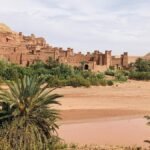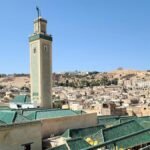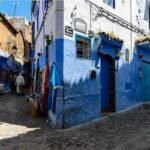Morocco is justly famous for its Saharan dunes and camel treks, its mountains and cedar forests with Barbary macaques, the red walls of Marrakech and the ancient medina of Fes and so on.
But under the surface lie secret treasures, for the geological past of Morocco is unique in the world and makes it the prime destination for both professional and amateur palaeontologists, fossil collectors, mineralogists and gemstone collectors as well as those seeking unique ornaments from “Orthoceras Marble” tables to a pretty fossil to put on the mantlepiece.
The country is also unusual in the current day and age for being one of the few places left that does not ban fossil collecting in some area or the export and sale of the material at home or via export.
Morocco has been under shallow seas, had mountain building periods as the tectonic plate the country lies on the edge of collides with Europe and has had volcanic events that have produced the most beautiful crystals and minerals.
Do visit the center of the Moroccan fossil trade at Erfoud, where there are workshops with expert preppers, wholesalers and shops dedicated to the fossils from all over the country, not just locally, so beware that if your fossil says Erfoud, it may have been prepped there, but might be from anywhere in the south of the country.
So here is a brief Guide To Moroccan Fossils And Minerals. The list is far from exhaustive, but includes the most famous and most spectacular of locations and specimens.
FOSSILS IN MOROCCO
Dinosaurs.
The Late Cretaceous deltaic sediments in the Kem Kem basin, southeast Morocco near the border with Algeria, abound with dinosaur fossils, Spinosaurus, a sail-backed carnivore probably bigger than Tyrannosaurus rex, huge sauropods, similar to Brontosaurus and others, as well as pterosaurs, the flying reptiles, crocodiles and many fish, often with big pointy teeth!
Safsaf, near Errachidia, is also a good location to find dinosaurs and crocodile fossils from slightly earlier in the Cretaceous.
Trilobites.
These enigmatic, beautiful creatures dominated the seas in the early Palaeozoic, and are some of the most desired fossils by collectors, Morocco has them in abundance from different eras, but the best place for collecting by hand is a Devonian area of the Hamada; the rocky Sahara, not too far from Merzouga where phacopids can be picked up without much of an effort.
Ask a local in Merzouga to get a guide to the area for a very reasonable price. He can probably also direct you to a nearby site where the trilobites are more likely enrolled, a defensive mechanism. d trilobite.
Boutchafine Mount, near Erfoud, is also a good location for Devonian trilobites as is Jbel Issomour, near Alnif, where incredible spiny and weird shaped trilobites are extracted and prepared, but this work takes the skill of an expert craftsman and many, and hours. Laatchana, also has a wealth of these most beautiful trilobites in the world.
Lots of earlier, Ordovician Flexicalynene and Colpocoryphe trilobites can be found without much of a search, in the vicinity of Jbel Tiskaouine, near Alnif. The Draa valley also is a great place for hunting Ordovician trilobites,
If you are seeking trilobites from the beginning of their existence, then seek out the more then half a billion-year-old specimens from Alnif. Some of these genera such as Cambropallas and Paradoxides are thirty centimetres ,or more, in length.
Mosasaurs.
These giant swimming reptiles were not dinosaurs, but actually a large marine lizard, and their teeth are common and very lovely in the phosphate deposits of Khourigba. Huge turtles, large fish and especially shark’s teeth, are common.
Shark’s Teeth.
Superb black coloured specimens of Cretaceous age are located in large numbers near Bakrit, near Ifrane, not far from Fes in the Middle Atlas Mountains. Superb fossils of starfish can be collected here as well.
Goniatites.
Often sold as ammonites, these are actually far older and have more simple walls to their dividing chambers. Again, Morocco produces some of the biggest and best in the world, so check out the areas north of Merzouga, ask for a guide, there are small ones here preserved in pyrite, haematite and goethite.
Shining, black pyritized goniatites can also be collected from near Fezzou.
Crinoids.
The beautiful species Scyphocrinites elegans is one of the most famous in the world. You can’t extract them yourself now, though you may find stem fragments on the surface, but they are collected and sold in the Erfoud region. People dig several meters into the ground, burrow under the crinoid layer, smash bits off and then glue the plate together again on the surface.
Orthocerid Nautiloids.
Found particularly in the Erfoud area, it is the long-shelled, bullet-shaped cephalopods that adorn the beautiful black limestones of the area and are a huge commercial success, being polished and made into products as diverse as sinks and fountains to Coca-Cola bottles! Actually, not Orthoceras, but related forms.
A great place to find your own is Serradrar, near Alnif, where the Silurian back limestones produce millions of the specimens which are extracted and polished for the commercial market.
Brachiopods.
My personal favourite. Several varieties are easy to collect at Timahdite, particularly Jurassic spiriferinids. Bivalves are common too. Specimens of both from the same age can also be picked up easily from the Ziz Gorges.
Sea Urchins.
The Cretaceous heart-urchin Micraster occurs plentifully in road cuts along the Ziz valley. Later, Eocene echinoids can be found around the spectacular hill of the kasbah Ait Benhaddou. Large coiled nautiloids also occur.
MINERALS IN MOROCCO
Amethyst.
Found in many places but, perhaps, the best spot to find this beautiful purple mineral is Sidi Rahal, just through the Tichka Pass en route to Marrakech, where also many varieties of chalcedony and agate may be collected or purchased.
Azurite and Malachite.
The first is dark blue, the second mid green. These copper-based minerals often occur together and are easy to obtain at Sidi Ayad, near Midelt along with gorgeous flourite specimens.
Barite.
Found with cerussite on galena very frequently at the old Mibladen mines near Midelt. Vanadinite also occurs here, but is less common. The nearby closed mine of Ahouli is well worth a visit for its collection of old mining equipment.
Lead and Manganese.
At the Mfis mine, Merzouga. Barite is more commonly found here today,
Olivine.
This emerald green crystal is found in abundance in the magmatic rocks of Jbel Hebri, a volcanic cone next to Michlifen, the winter ski resort not far from Fes in the Middle Atlas. Various interesting intrusive igneous rocks are also found here.
Sand Roses.
A naturally forming variety of gypsum, these can be found and bought all over the desert areas of Morocco, but be careful, the mineral is very soft and easily damaged.
Selenite.
A beautiful, striated, crystalline spar version of gypsum this is found in abundance in Morocco and is very cheap to purchase here. It is so soft that it is easily carved into hearts, spires and screw-shapes, but is not recommended for jewellery in the long-term because it will just wear away.
Vanadinite.
Probably the best specimens in the world of this very beautiful brown/ orange / purple crystal, much sought after by collectors and tourists alike, are found at the Filon 12 mine near Merzouga. The beds are rich in quartz, citrine and many other minerals, too.
So, if fossils and minerals interest you, whether you are a casual collector or an experienced paleontologist or gemologist, then Morocco is the destination of choice for you. Nowhere else has such a wide, unique and easily accessible range of localities for fossils and crystals from a time period of more than half a billion years within the same geographical area than us here in welcoming Morocco’





